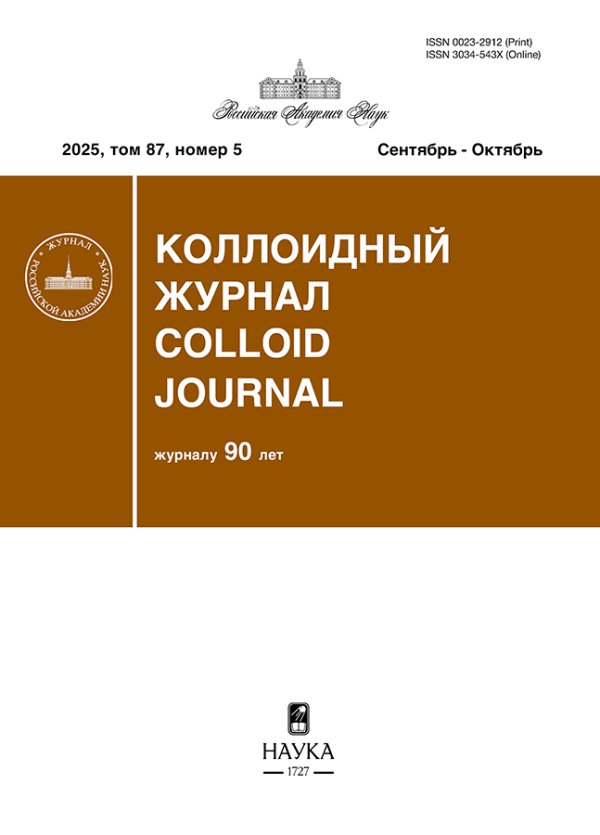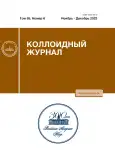Влияние старения и модификации на межфазное взаимодействие в асфальтовых вяжущих
- Авторы: Дударева Т.В.1, Красоткина И.А.1, Гордеева И.В.1, Никольский В.Г.1, Горелышева Л.А.2, Гарманов В.Н.2
-
Учреждения:
- Федеральный исследовательский центр химической физики им. Н.Н. Семенова РАН
- ФАУ “Российский дорожный научно-исследовательский институт”
- Выпуск: Том 85, № 6 (2023)
- Страницы: 717-726
- Раздел: Статьи
- Статья получена: 25.12.2023
- Статья опубликована: 01.11.2023
- URL: https://journals.rcsi.science/0023-2912/article/view/231786
- DOI: https://doi.org/10.31857/S0023291223600451
- EDN: https://elibrary.ru/FQNNEY
- ID: 231786
Цитировать
Полный текст
Аннотация
В диапазоне температур –10–30°С исследовано влияние термоокислительного старения, частоты и деформации на межфазное взаимодействие по параметрам K–B–G* и К–В–δ в асфальтовом вяжущем и модифицированном асфальтовом вяжущем на основе битума марки БНД60/90. Наполнитель вводили в битум в соотношении 1/1 по массе. Активный порошок дискретно девулканизованной резины (АПДДР) в качестве модификатора вводился в соотношении битум/АПДДР = 87.5/12.5 по массе. Показано, что модификация АПДДР обеспечивает большую по сравнению с асфальтовым вяжущим толщину адсорбированного слоя на поверхности частиц наполнителя при различных условиях внешних воздействий, причем эта толщина зависит от последовательности введения наполнителя и АПДДР.
Ключевые слова
Об авторах
Т. В. Дударева
Федеральный исследовательский центр химической физикиим. Н.Н. Семенова РАН
Email: yanadva@mail.ru
Россия, 119991, Москва, ул. Косыгина, 4
И. А. Красоткина
Федеральный исследовательский центр химической физикиим. Н.Н. Семенова РАН
Email: yanadva@mail.ru
Россия, 119991, Москва, ул. Косыгина, 4
И. В. Гордеева
Федеральный исследовательский центр химической физикиим. Н.Н. Семенова РАН
Email: yanadva@mail.ru
Россия, 119991, Москва, ул. Косыгина, 4
В. Г. Никольский
Федеральный исследовательский центр химической физикиим. Н.Н. Семенова РАН
Email: yanadva@mail.ru
Россия, 119991, Москва, ул. Косыгина, 4
Л. А. Горелышева
ФАУ “Российский дорожный научно-исследовательский институт”
Email: yanadva@mail.ru
Россия, 125493, Москва, ул. Смольная, 2
В. Н. Гарманов
ФАУ “Российский дорожный научно-исследовательский институт”
Автор, ответственный за переписку.
Email: yanadva@mail.ru
Россия, 125493, Москва, ул. Смольная, 2
Список литературы
- Davis C., Castorena C. Implications of physico-chemical interactions in asphalt mastics on asphalt microstructure // Construction and Building Materials. 2015. V. 94. P. 83–89. https://doi.org/10.1016/j.conbuildmat.2015.06.026
- Wu W., Jiang W., Yuan D., Lu R., Shan J., Xiao J., Ogbon A.W. A review of asphalt-filler interaction: Mechanisms, evaluation methods, and influencing factors // Construction and Building Materials. 2021. V. 299. P. 124279. https://doi.org/10.1016/j.conbuildmat.2021.124279
- Li F., Yang Y., Wang L. Evaluation of physicochemical interaction between asphalt binder and mineral filler through interfacial adsorbed film thickness // Construction and Building Materials. 2020. V. 252. P. 119135. https://doi.org/10.1016/j.conbuildmat.2020.119135
- Rahim A., Milad A., Yusoff N.I., Airey G., Nick Thom N. Stiffening effect of fillers based on rheology and micromechanics models // Applied Sciences. 2021. V. 11. № 14. P. 6521. https://doi.org/10.3390/app11146521
- Kim M., Buttlar W.G. Stiffening mechanisms of asphalt–aggregate mixtures: From binder to mixture // Transportation Research Record. 2010. V. 2181. № 1. P. 98–108. https://doi.org/10.3141/2181-11
- Clopotel C., Velasquez R., Bahia H. Measuring physico-chemical interaction in mastics using glass transition // Road Materials and Pavement Design. 2012. V. 13. № 1. P. 304–320. https://doi.org/10.1080/14680629.2012.657095
- Underwood B.S. Experimental investigation into the multiscale behaviour of asphalt concrete // International Journal of Pavement Engineering. 2011. V. 12. № 4. P. 357–370. https://doi.org/10.1080/10298436.2011.574136
- Cardone F., Frigio F., Ferrotti G., Canestrar F. Influence of mineral fillers on the rheological response of polymer-modified bitumens and mastics // Journal of Traffic and Transportation Engineering (English Edition). 2015. V. 2. № 6. P. 373–381. https://doi.org/10.1016/j.jtte.2015.06.003
- Dong Z., Liu Z., Wang P., Zhou T. Modeling asphalt mastic modulus considering substrate–mastic interaction and adhesion // Construction and Building Materials. 2018. V. 166. P. 324–333. https://doi.org/10.1016/j.conbuildmat.2018.01.140
- Guo M., Bhasin A., Tan Y. Effect of mineral fillers adsorption on rheological and chemical properties of asphalt binder // Construction and Building Materials. 2017. V. 141. P. 152–159. https://doi.org/10.1016/j.conbuildmat.2017.02.051
- Alfaqawi R.M., Airey G.D., Presti D.Lo, Grenfell J. Effects of mineral fillers on bitumen mastic chemistry and rheology // In: Transport Infrastructure and Systems 2017.Proceedings of the AIIT International Congress on Transport Infrastructure and Systems (TIS 2017), Rome, Italy, 10–12 April 2017. https://doi.org/10.1201/9781315281896-48
- Moraes R., Bahia H.U. Effect of mineral filler on changes in molecular size distribution of asphalts during oxidative ageing // Road Materials and Pavement Design. 2015. V. 16. № S2. P. 55–72. https://doi.org/10.1080/14680629.2015.1076998
- Tan Y., Guo M. Interfacial thickness and interaction between asphalt and mineral fillers // Materials and Structures. 2014. V. 47. P. 605–614. https://doi.org/10.1617/s11527-013-0083-8
- Diab A., You Z. Linear and nonlinear rheological properties of bituminous mastics under large amplitude oscillatory shear testing // Journal of Materials in Civil Engineering. 2018. V. 30. № 3. P. 04017303. https://doi.org/10.1061/(ASCE)MT.1943-5533.0002179
- Guo M., Tan Y.Q., Yu J.X., Hou Y., Wang L.B. A direct characterization of interfacial interaction between asphalt binder and mineral fillers by atomic force microscopy // Materials and Structures. 2017. V. 50. P. 141. https://doi.org/10.1617/s11527-017-1015-9
- Xu W., Qiu X., Xiao S., Hong H., Wang F., Yuan J. Characteristics and mechanisms of asphalt–filler interactions from a multi-scale perspective // Materials. 2020. V. 13. № 12. P. 2744. https://doi.org/10.3390/ma13122744
- Palierne J.F. Linear rheology of viscoelastic emulsions with interfacial-tension // Rheologica Acta. 1990. V. 29. № 3. P. 204–214. https://doi.org/10.1007/BF01331356
- Ziegel K.D., Romanov A. Modulus reinforcement in elastomer composites. I. Inorganic fillers // Journal of Applied Polymer Science. 1973. V. 17. № 4. P. 1119–1131. https://doi.org/10.1002/app.1973.070170410
- Ibarra L., Panos D. Dynamic properties of thermoplastic butadiene-styrene (SBS) and oxidized short carbon fiber composite materials // Journal of Applied Polymer Science. 1998. V. 67. № 10. P. 1819–1826. https://doi.org/10.1002/(SICI)1097-4628(19980307) 67:10<1819::AID-APP15>3.0.CO;2-R
- Liu G., Zhao Y., Zhou J., Li J., Yang T., Zhan J. Applicability of evaluation indices for asphalt and filler interaction ability // Construction and Building Materials. 2017. V. 148. P. 599–609. https://doi.org/10.1016/j.conbuildmat.2017.05.089
- Guo M., Tan Y., Hou Y., Wang L., Wang Y. Improvement of evaluation indicator of interfacial interaction between asphalt binder and mineral fillers // Construction and Building Materials. 2017. V. 151. P. 236–245. https://doi.org/10.1016/j.conbuildmat.2017.05.003
- Guo M., Tan Y. Interaction between asphalt and mineral fillers and its correlation to mastics’viscoelasticity // International Journal of Pavement Engineering. 2021. V. 22. № 1. P. 1–10. https://doi.org/10.1080/10298436.2019.1575379
- Frigio F., Ferrotti G., Cardone F. Fatigue Rheological characterization of polymer-modified bitumens and mastics // In: 8th RILEM International Symposium on Testing and Characterization of Sustainable and Innovative Bituminous Materials. 2016. V. 11. P. 655–666. https://doi.org/10.1007/978-94-017-7342-3_53
- Mazzoni G., Virgili A., Canestrari F. Influence of different fillers and SBS modified bituminous blends on fatigue, self-healing and thixotropic performance of mastics // Road Materials and Pavement Design. 2019. V. 20. № 3. P. 656–670. https://doi.org/10.1080/14680629.2017.1417150
- Li F., Yang Y. Understanding the temperature and loading frequency effects on physicochemical interaction ability between mineral filler and asphalt binder using molecular dynamic simulation and rheological experiments // Construction and Building Materials. 2020. V. 244. P. 118311. https://doi.org/10.1016/j.conbuildmat.2020.118311
- Chen M., Javilla B., Hong W., Pan C., Riara M., Mo L., Guo M. Rheological and interaction analysis of asphalt binder, mastic and mortar // Materials. 2019. V. 12. № 1. P. 128. https://doi.org/10.3390/ma12010128
- Nikol’skii V., Dudareva T., Krasotkina I., Gordeeva I., Vetcher A.A., Botin A. Ultra-dispersed powders produced by high-temperature shear-induced grinding of worn-out tire and products of their interaction with hot bitumen // Polymers. 2022. V. 14. № 17. P. 3627. https://doi.org/10.3390/polym14173627
- Nikol’skii V., Dudareva T., Krasotkina I., Gordeeva I., Gorbativa V., Vetcher A.A., Botin A. Mechanism of multi-stage degradation in hot bitumen of micronized Elastomeric Powder Modifiers from worn-out tire’s rubber // Polymers. 2022. V. 14. № 19. P. 4112. https://doi.org/10.3390/polym14194112
- Никольский В.Г., Красоткина И.А., Дударева Т.В., Горелышева Л.А., Гарманов В.Н. Влияние старения и модификации на релаксационные свойства нефтяного дорожного битума и асфальтового вяжущего // Клеи. Герметики. Технологии. 2022. № 10. С. 31–39. https://doi.org/10.31044/1813-7008-2022-0-10-31-39
- ГОСТ 22245-90. Битумы нефтяные дорожные вязкие. Технические условия
- Методика измерений группового химического состава тяжелых нефтепродуктов методом жидкостно-адсорбционной хроматографии с градиентным вытеснением. Уфа, 2014. 18 с.
- ГОСТ Р 52129-2003. Порошок минеральный для асфальтобетонных и органоминеральных смесей. Технические условия
- Gordeeva I.V., Dudareva T.V., Krasotkina I.A., Nikol’skii V.G., Naumova Yu.A., Sinkevich M.Yu., Lobachev V.A. Methodological aspects of evaluating the particle size distribution of powder elastomeric materials // Key Engineering Materials. 2021. V. 899. P. 58−66. https://doi.org/10.4028/www.scientific.net/KEM.899.58
- Berlin A.A., Nikolskiy V.G., Krasotkina I.A., Dudareva T.V., Gorbarova V.N., Gordeeva I.V., Sorokin A.V., Lobachev V.A., Dubina S.I., Sinkevich M.Yu. Rubber and rubber-polymer modifiers of asphalt concrete mixtures produced by method of high-temperature shear grinding. Part 3. Evaluation of modification efficiency // Polymer Science, Ser. D. 2022. V. 15. № 1. P. 71–78. https://doi.org/10.1134/S199542122201004X
- ГОСТ 33140-2014. Дороги автомобильные общего пользования. Битумы нефтяные дорожные вязкие. Метод определения старения под воздействием высокой температуры и воздуха (метод RTFOT). [AASHTO T 240-13 Standard Method of Test for Effect of Heat and Air on a Moving Film of Asphalt (Rolling Thin-Film Oven Test)] (2017).
- Laukkanen O.V., Soenen H., Winter H.H., Seppälä J. Low-temperature rheological and morphological characterization of SBS modified bitumen // Construction and Building Materials. 2018. V. 179. P. 348–359. https://doi.org/10.1016/j.conbuildmat.2018.05.160
- Gorbatova V.N., Gordeeva I.V., Dudareva T.V., Krasotkina I.A., Nikol’skii V.G., Egorov V.M. Effect of the active powder of discretely devulcanized rubber on bitumen properties at low temperatures // Nanotechnologies in Construction. 2023. V. 15 № 1. P. 72–83. https://doi.org/10.15828/2075-8545-2023-15-1-72-83
- Ma X., Chen H., Gui C., Xing M., Yang P. et al. Influence of the properties of an asphalt binder on the rheological performance of mastic // Construction and Building Materials. 2019. V. 227. P. 116659. https://doi.org/10.1016/j.conbuildmat.2019.08.040
- Mturi G., O’Connell J., Zoorob S.E., De Beer M. A study of crumb rubber modified bitumen used in South Africa // Road Materials and Pavement Design. 2014. V. 15. № 4. P. 774–790. https://doi.org/10.1080/14680629.2014.910130
Дополнительные файлы

















